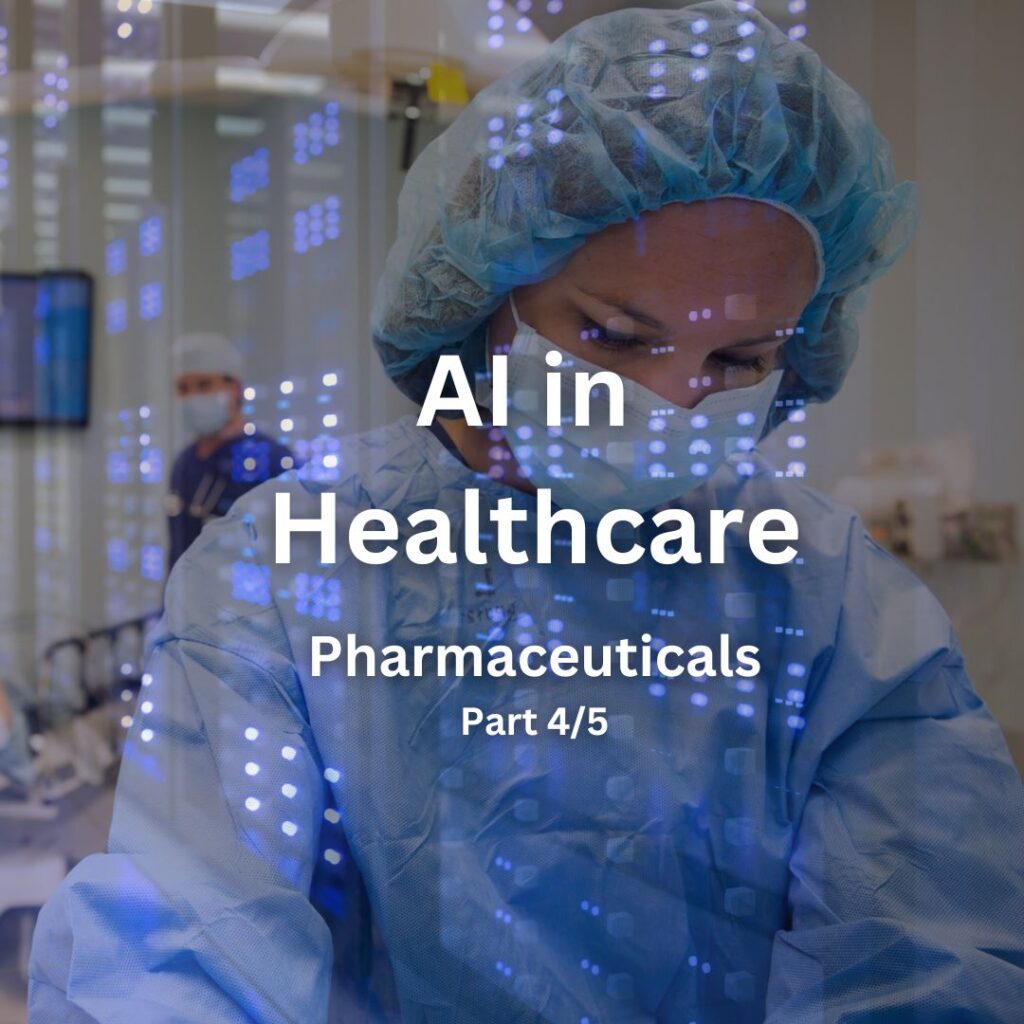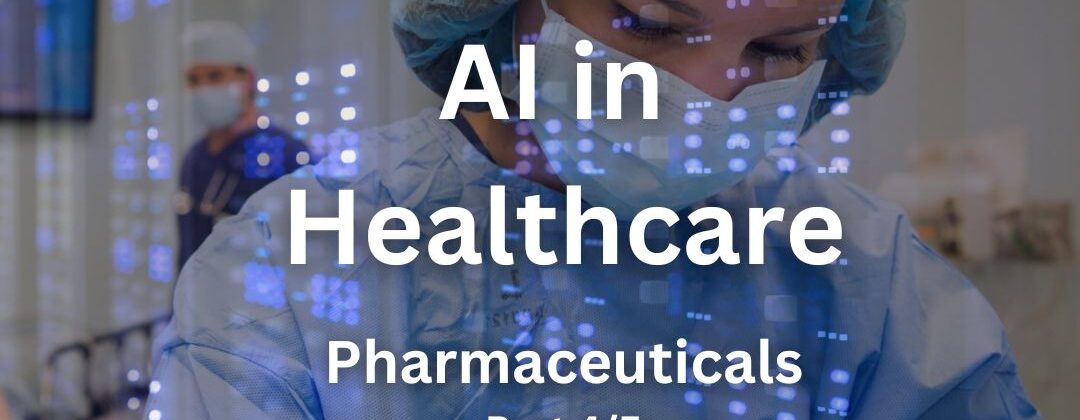
This is Part 4 in the Artificial Intelligence (AI) series in healthcare. Previous articles provided a general introduction (Part 1), how clinicians are using AI (Part 2), and how health systems are using AI (part 3). In Part 4, I move into the area of drug development using AI; I’m using the word drug to refer to any medication developed and marketed by the industry. This area will see the most impact in healthcare over the next five years or earlier.
First, a short note. My experience in the pharmaceutical industry is more limited than in the provider side of healthcare. I have performed several small projects in back office operations, not discovery, development, regulations, or marketing. My knowledge comes from discussions with those in the industry and reading many books and journals over the past several years to help me better understand the industry. I’ve also used the very thing I’m writing about, AI, to expand my knowledge in this field. Please read this article with that in mind and feel free to offer corrections where appropriate. Be gentle. So, let’s dive in.
An Overview of the Industry
We have all taken drugs at some point in our lives, hopefully keeping on the right side of the law. Getting a medication to the point where it becomes safe to take involves a large amount of research and money. AI is transforming the pharmaceutical industry by improving drug discovery and delivery efficiency, accuracy, and speed. The following is a brief overview of bringing a medication to market and, more importantly, into your body.
The Big Picture
The way drugs come to market varies, but they usually take the same approach. The (very) general process is listed below.
Discovery: Identifying potential drug candidates and their targets. this can start by finding new molecules to pair together and see what they do, to attempting to neutralize a disease or kill bacteria. Costs for this stage are extremely varied as they can expand an existing drug or find something totally new.
Preclinical Research: Conducting in vitro (test tube) and in vivo (in a living organism) studies to evaluate the safety and effectiveness of drug candidates. These two steps can cost hundreds of thousands of dollars to several million.
Clinical Trials: This is where testing the drug candidates in humans goes through multiple phases (Phase I, II, III, and sometimes Phase IV). Phases start with a small number of test subjects and then increase the number as well as dosages and other variables to determine boundaries of efficacy. Depending on the drug, number of patients tested, new vs. existing, and many other factors, costs can run between $21MM and $350MM. See Examination of Clinical Trial Costs for more detail.
Regulatory Approval: Submitting the drug for review and approval by regulatory agencies is a long process involving new drugs, less so with modification of existing drugs. Agencies like the Food and Drug Administration (FDA) in the US, Health Canada, the European Medicines Agency, and many others are charged with ensuring drugs are safe for their respective countries. This is where others review and validate the company’s process and outcomes and ask questions to better understand it so they can make an informed decision for approval. Costs during this stage can vary between $100 million to several hundred million as companies work their way through agencies around the globe.
Production: Manufacturing the approved drug on a large scale can be done anywhere if companies abide by the many regulations around sterile, clean, accountable, safe environments. There are many regulations around manufacturing drugs, and they can be country-specific. Construction of a new plant for a new drug can be in the tens of millions of dollars.
Marketing: Promoting the drug to healthcare professionals and patients costs a lot. Just think of all those ads you see when watching a show or swiping through stuff on your phone. Many companies started using direct-to-consumer marketing years ago to increase knowledge about their product and have people recommend them to their doctors, which doctors love, I’m sure. It is estimated that marketing a new drug can range from $100 million to $1 billion.
Reporting and Maintenance: Monitoring the drug’s safety and efficacy post-approval and making necessary adjustments is ongoing. Costs can also vary widely, depending on factors such as the specific therapeutic area, the complexity of the drug, and the resources required for continuing development and support. However, it is estimated that the cost of maintaining a drug on the market can range from $10 million to $100 million per year.
As you can see, bringing a new drug or modifying an existing drug can take a very long time and be very expensive. AI is helping reduce time and costs and will be tightly integrated into every process moving forward. I will focus on the discovery phase as several innovations are underway in these areas, with many more to come.
Discovery
For a good book on the history of drug discovery, I recommend “The Drug Hunters” by Kirsch and Ogas, where they take you on the journey of discovering the earliest drugs, improvements, and the market.
Briefly, the field of drug discovery has come a long way over the past century. Early efforts in the 1900s involved isolated experimentation and screening natural products like molds, plants, and microbes for biological activity. This led to discoveries such as Alexander Flemings breakthrough of the first true antibiotic, penicillin, in 1928. Its hard to believe that the pharmaceutical industry is less than a hundred years old, although the chemical industry from which pharma originates is thousands of years old.
The mid-20th century saw a significant boom in antibiotic discovery through systematic cultivation and screening of microbial samples. Companies aggressively tested soil extracts on bacteria, yielding antibiotics like streptomycin for bacterial infections, including tuberculosis; chloramphenicol for treat meningitis, plague, cholera, and typhoid fever; and tetracyclines, a broad based antibacterial.
Advances in genomics in the 1980s and 90s provided novel targets and accelerated the development of rationally designed drugs. High-throughput screening of large chemical libraries against biological targets of interest produced new medicines. However, diminishing returns were seen as targeting grew more complex.nbsp;
By the 2000s, most large pharmaceutical firms exited antibacterial research due to high costs and failure rates, which can be as high as 90%. The few who remained focused on variations of existing drugs. At the same time, rampant overuse drove rising antibiotic resistance globally.nbsp;
Recent efforts employ new techniques such as chemical synthesis, fragment-based design, and virtual screening using technologies like tissues or organs on a slide.
Machine learning aids drug discovery by leveraging existing data to uncover candidates faster than previous methods. With refinement, artificial intelligence, and cross-disciplinary collaborations show promise to revolutionize how we develop treatments for our most pressing health threats.
In a paper recently published in Nature, researchers from MIT and Harvard used elements of AI to discover a new class of antibiotics. They trained neural networks to screen thousands of chemical compounds to find ones that kill Methicillin-resistant Staphylococcus aureus (MRSA), a cause of staph infection bacteria, without harming human cells.
To do this:
- They collected data on over 39,000 compounds, testing each against MRSA and human cells.
- They then trained 80 neural networks to predict if compounds would be antibiotics or toxic.
- After screening over 12 million additional compounds, they identified around 3,600 that seemed to kill MRSA without toxicity.
- By removing atom by atom, they figured out the basic chemical structures needed for antibiotic effects.
- In the lab, they tested 241 unknown compounds predicted to work. Amazingly, over 8% inhibited MRSA growth.
- They also tested 30 compounds expected to not work, and none did – showing their AI approach was on to something.
- Further, two top compounds worked via a novel method and inhibited other drug-resistant bugs. One even cured mice infections!
Another example is described in the MIT Tech Review, where researchers identified a potential new drug in 46 days!
As neural networks find new medicines, this will revolutionize healthcare by reducing development time and testing costs.
Bertalan Mesko, MD, PhD, wrote a great article that lists some of the companies involved in this area, “Top 6 Companies Using AI In Drug Discovery And Development,” its worth the read.
I would also recommend an excellent article by McKinsey: “How Artificial Intelligence can power clinical development.“
Google’s DeepMind’s AlphaFold project has accelerated the whole industry by providing fantastic insight into how proteins, the basis of all life, are structured.
Recent Partnerships in AI-Driven Drug Development
Several pharmaceutical companies have partnered to leverage AI in their drug development efforts. Some notable examples include:
1. Exscientia and Bayer: Combining Exscientia’s AI platform with Bayer’s drug development expertise.
2. Merck and BenchSci, Atomwise, C4 Therapeutics, and Acellera with their ACMED platform: Partnering on various AI drug discovery and development initiatives.
3. GSK and Cloud Pharmaceuticals, Insilico Medicine: Utilizing AI platforms for drug design and lead generation.
4. Roche and Recursion Pharmaceuticals: Partnering to use AI platforms for drug discovery.
5. Sanofi and Aily Labs: Developing an AI platform called “plai” for drug discovery, clinical trials, and manufacturing.
Brian Buntz has a more complete list in his article: “How 11 Big Pharma companies are using AI.”
These partnerships demonstrate the growing interest in AI-driven drug development and the potential for AI to transform the pharmaceutical industry.
Summary
AI will speed up the long and expensive process of designing drugs. It can help identify drug targets, create new drug molecules, find existing drugs that could be repurposed for new uses, and predict how drugs will react in the body and work against diseases. Drug companies are already using AI to help with their work, and this will accelerate as they partner with others to discover and repurpose drugs from now on.
Machine learning and neural networks will help understand complex biology, design better drug molecules, and create innovative health systems. Quality and safety of drugs will improve as well. Building an AI system that balances all these well will be a considerable challenge requiring collaboration across multiple disciplines to get it right.
My goal with this article was to introduce you to the pharmaceutical industry and help you understand the impact AI is having on healthcare and how it will accelerate in the short term. If you have time, review the links to better understand what is being done to bring better drugs to market with less time and expense. These techniques will bring us closer to precision medicine, with more precise therapies targeting a particular disease. The future is bright!


Leave a Reply